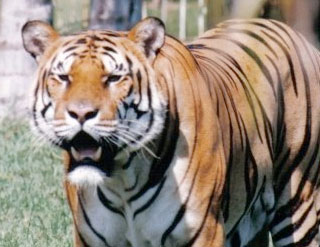Status: Appendix I of CITES, Endangered Species
 Latin Name: Panthera tigris
Latin Name: Panthera tigris
Common Name: Tiger
Kingdom: Animalia
Phylum: Chordata (vertebrata)
Class: Mammalia
Order: Carnivora
Family: Felidae
Genus: Panthera
Species: Tigris
Size: Adult males weigh on the average 330 lb to 680 lb
Adult females weigh on the average 220 lb to 350 lb
Adult male’s length on the average 8’6″ to 10’9″
Adult female’s length on the average 7’6″ and 9′
Note: There are subspecies of tigers which are smaller (Corbette) and which are larger (Amur).
Subspecies:
Endangered:
Bengal Tiger (Panthera tigris tigris)
Indochinese Tiger (Panthera tigris corbetti), another name is the Corbetts tiger
Sumatran Tiger (Panthera tigris sumatrae)
Siberian Tiger (Panthera tigris altaica), another name is the Amur, Manchurian or North China tiger
South China Tiger (Panthera tigris amoyensis), another name is the Amoy or Xiamen tiger. The South China Tiger is the most critically endangered subspecies.
Extinct:
Javan Tiger (Panthera tigris mondaica)
Caspian Tiger (Panthera tigris virgata)
Balinese Tiger (Panthera tigris balica)
Appearance: Coat (fur) can be any variance of color, from yellow to orange/red. White areas on the chest, neck, and the inside of the legs. Stripes coloration can vary from brown/grey to pure black. Form/density of the strips differs within the subspecies, approx. 100 stripes or more. Different subspecies of tiger have somewhat different appearances and variations. Bengal tigers have white color variation.
Habitat: Varies widely, from tropical rainforests to snow-covered coniferous and deciduous forests and from mangrove swamps to drier forests.
Distribution: Tigers occur in parts of India, Manchuria, China, Indonesia, Russia (Siberia).
Asia – primarily in forest lands, but noted some tigers live in areas with tall grasses and vegetation.
Reproduction and Growth: Tigers usually breed during winter season.
Females reach sexual maturity at about 3 years old. Males reach maturity in about 4 years. Females give birth to 2-4 blind cubs about 103 days later. Cubs weigh about 2-3 pounds at birth.
Cubs are dependent on the mother for about a year and a half.
Hunting: Mostly active at night, primarily nocturnal. (active during the day during winter)
Diet: Prey consists mostly of pigs, deer, antelope, buffalo and other large mammals, although tigers have been known to hunt smaller mammals and birds.
Lifespan: wide range – approx. 15 years in the wild; 20+ years in captivity.
Social System and Communication: Solitary animals except for mating. On rare occasion it has been noted tigers will gather to share a large kill. Tigers mark their territory by urine spraying, fecal drops or scratch marks onto trees.
Principal Threats: Habitat destruction and the destruction of prey.
